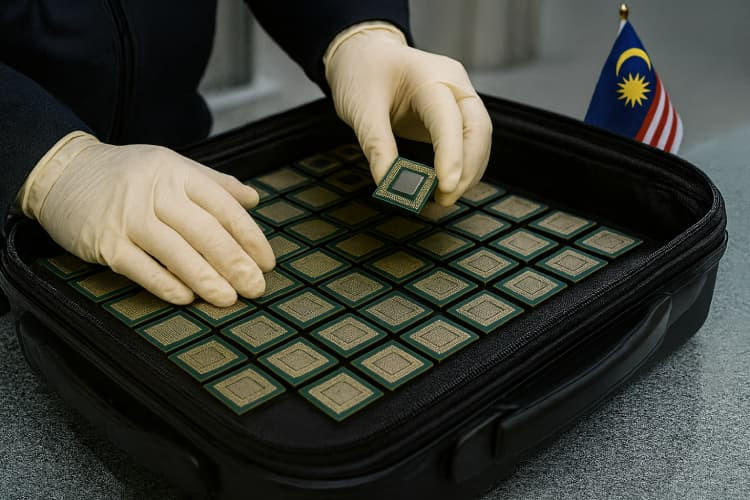Malaysia Trade Permit AI Chips Rule Targets US Tech
Insights | 18-08-2025 | By Robin Mitchell

Key Things to Know:
- The United States’ semiconductor export restrictions have triggered a global surge in illicit chip trading and parallel supply chains.
- Malaysia now requires a Strategic Trade Permit for the export, transshipment, or transit of U.S.-origin high-performance AI chips, under Directive 1/2025.
- Compliance requires a 30-day notice period and submission of an AI Chip Assessment (AICA) form before approval by MITI.
- China’s accelerated chip development and RISC-V adoption are raising questions about the long-term effectiveness of Western export controls.
When the United States began tightening its grip on semiconductor exports, the move was framed as a bold strategy to protect national security and maintain technological supremacy. But in today’s globally entangled tech landscape, such restrictions don’t just cause friction, they ignite entire black markets. From suitcases stuffed with high-end chips to entire nations reconfiguring their supply chains, the fallout has been anything but orderly.
So what exactly triggered this wave of illicit chip trade? How are countries like Malaysia responding? And crucially, have these restrictions helped, or merely hastened, the rise of a rival silicon superpower?
Illegal Chip Trade and the Challenges of Restricted Countries
When the United States imposed sweeping export restrictions to prevent China from accessing advanced semiconductors, it lit a fuse under the global tech economy. What followed was a series of bold, bizarre, and sometimes outright illegal moves that showcase just how far a nation, or a desperate engineer, will go to get silicon.
The US restricting access to high-end chips wasn't a half-measure; it was a deliberate and forceful push to limit China's ability to develop cutting-edge AI systems, military tech, and next-generation computing infrastructure. Now, on paper, the logic made sense: cut off the supply, and you throttle the progress. But as with most embargo-style tactics, enforcement isn't clean, and innovation doesn't sleep.
Almost immediately, Chinese companies began exploring every workaround imaginable. Some spun up shell corporations in third-party countries, while others funnelled purchases through tangled webs of "friendly" distributors. And then, there's the truly creative side of this story, engineers smuggling chips in their luggage, their clothing, and in some rare cases, even strapped to their bodies. These devices were not SD cards or hobbyist microcontrollers; they were high-value, high-specification chips, sometimes worth tens of thousands of dollars per kilogram, if you're measuring by market impact rather than weight.
If this sounds like something out of a Cold War spy thriller, you're not far off. But despite the blockade, China hasn't just survived these restrictions; it thrived. Through massive state investment, relentless reverse engineering, and a willingness to take technological moonshots, the country now produces some of the most advanced chips on the planet without relying on Western tech stacks. The 7nm node? Achieved. AI accelerators? Mass-produced. China can be said to be the personification of "hold my beer".
This puts the effectiveness of these restrictions in serious question. Have they delayed China's chip capabilities? Maybe. But they've also incentivised self-reliance in ways that the West might come to regret.
Malaysia Imposes Trade Permit Requirement on U.S.-Origin AI Chips
Malaysia's trade ministry announced on Monday that the export, transshipment, and transit of high-performance artificial intelligence chips originating from the United States will now require a trade permit, effective immediately. This new regulation aims to tighten controls on advanced semiconductor technology amid growing global concerns over chip proliferation.
To add clarity, the requirement is based on the “catch‑all control” under Section 12 of the Strategic Trade Act 2010, which empowers MITI to regulate items not specifically listed if there is reasonable suspicion of misuse or restricted end‑use.
Directive No. 1/2025 further refines this requirement by defining specific chip categories, including GPUs, TPUs and AI accelerators, that qualify under Annex I of the directive, and stipulates that exporters must supply a re‑export licence and export‑control classification along with the permit application.
Directive 1/2025: New Compliance Steps for AI Chip Exports
According to the ministry's statement, individuals and companies must notify Malaysian authorities at least 30 days in advance before exporting or moving any such AI chips that are not already listed under Malaysia's strategic items. The move is designed to close regulatory loopholes while the government reviews whether to formally add these high-performance AI chips of US origin to its official strategic items list.
Importantly, the accompanying industry guideline outlines a three‑step process for compliance: assess whether your product meets the “Advanced AI Chip” parameters as per Annex I, complete and submit an AI Chip Assessment (AICA) form at least 30 days in advance, and await MITI’s determination on permit necessity.
Compliance Workflow and Geopolitical Implications
Malaysia has faced increasing pressure, particularly from the United States, to restrict the flow of critical semiconductor components to China, an effort tied to safeguarding national security and protecting cutting-edge technological development. The Financial Times reported earlier this year that Malaysia has been working to strengthen semiconductor export rules as part of these efforts.
Analysts note this aligns Malaysia more closely with international export‑control norms, especially the U.S. Export Administration Regulations (EAR), as the Directive’s Annex I uses classification codes mirroring U.S. EAR categories, raising the threshold for technical specificity in compliance efforts.
Observers warn that without clear enforcement protocols, the 30‑day notification may create bottlenecks for businesses, particularly SMEs, unless accompanied by streamlined procedures and active oversight.
Enforcement Challenges and Regulatory Commitment
The trade ministry emphasised Malaysia's firm stance against any attempts to bypass export controls or engage in illicit trade, warning that violators will face strict legal consequences.
Under the STA 2010, breaching Section 12 can lead to significant penalties depending on intent, ranging from reputational damage to legal consequences. This emphasises the importance of robust internal compliance frameworks, due diligence on end‑use, and accurate product classification for those handling high‑performance AI chips.
Separately, Malaysian authorities are investigating potential breaches of local laws involving shipments of servers connected to a fraud case in Singapore, as these servers may contain advanced chips subject to US export restrictions.
Are These Restrictions Too Late?
Looking at the current state of China's semiconductor industry, you have to ask: are these restrictions too late to matter? Because if the goal was to freeze China out of the advanced chip market, someone forgot to check the scoreboard.
The country has already shifted its focus toward technological sovereignty, and frankly, the appetite for foreign chips may be fading, not just out of necessity, but out of principle. When the US effectively flipped a switch and paralysed entire segments of China's tech stack, it sent a clear message: your systems are only safe until we say otherwise. From that point forward, full independence wasn't just a strategic goal; it became a national imperative.
But here is where things might be highly ironic, as even if all restrictions were lifted tomorrow, it's unclear whether Chinese companies would continue using Western silicon. Years of sanctions have birthed home-grown alternatives that, while not always on par, are "good enough" for many applications. In some cases, like AI accelerator chips from Huawei or domestic 7nm processors from SMIC, they're getting impressively close to the cutting edge.
And that leads us to the weird case of RISC-V. Technically, it's an open-source instruction set developed in the West, but it's gained massive traction in China. Why? Because the US can't sanction it. There's no export license to revoke, no hardware dependency to block, which means that for Chinese companies trying to de-risk their designs, it's a no-brainer.
So yes, these restrictions may not only be late, but they may be functionally obsolete. They've arguably done more to accelerate China's independence than to hinder its development, and in the process, they've exposed just how much of the tech world is built on geopolitical quicksand.
But here's the flip side, and it's a question we're not asking nearly enough: Should we be concerned about high-performance technology coming from China?
As Chinese companies begin producing competitive AI chips, custom CPUs, and communications hardware that rivals or exceeds Western offerings, the flow of advanced tech may not just be a one-way concern anymore. If the West truly wants to protect its own digital infrastructure, it may need to think beyond outbound restrictions and start seriously considering inbound safeguards.
Because this isn't just about keeping chips out of the wrong hands. It's about preparing for a world where we're no longer the ones holding the best cards.

